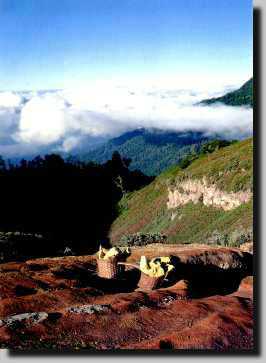 |
We
arrived at the crater rim just as the sun appeared over the summit
of Merapi. The sight was breathtaking. From the still, deep blue
surface of the lake, heavily fissured white rock walls rose about
200 metres, enclosing the crater. To the north east we could
see the distant peak of Mt Baluran. Below, at the lake's edge,
was a scene from Dante's inferno. Small figures could be seen
labouring amidst billowing clouds of smoke in the sulphur quarry.
As we descended towards the mine, the rising sun began to warm
the surface of the lake, which soon changed to a sinister milky
turquoise colour. Ripples appeared in the water, disturbing the
bright yellow, amoeba-like streaks of sulphur, which until that
moment had rested motionless. Half an hour later, when we arrived
at the lake shore, the water had begun steaming.
The sulphur, we learned, is transported entirely on foot. In
the past, horses were used but they were found to be less practical
on the hazardous terrain. Today, the mine yields nine to twelve
tons of sulphur per day. Individual loads of up to 70 kgs are
carried by men, often barefooted, up to the rim of the crater
and then 17 km down the mountainside to a factory near Banyuwangi.
The porters are paid by weight. After arrival at the factory,
the sulphur is treated before being used in the production of
medicines and as an important element in the processing of sugar. |

